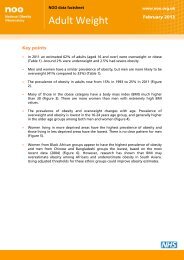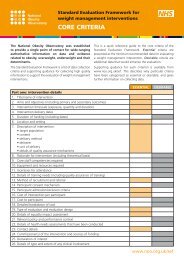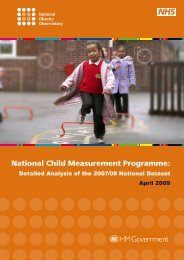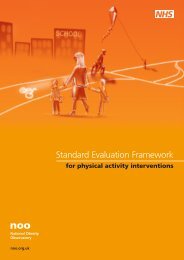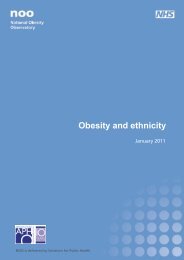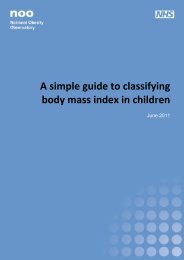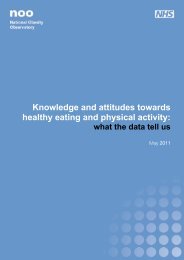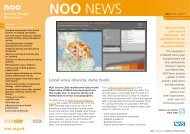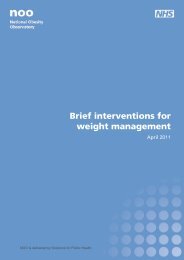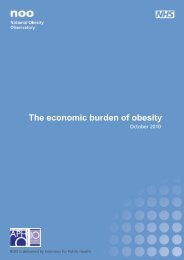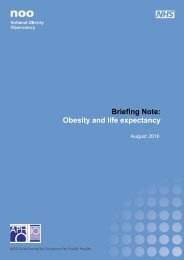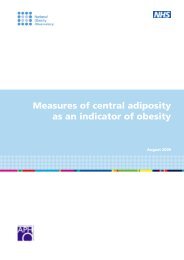Review of dietary assessment methods in public health - National ...
Review of dietary assessment methods in public health - National ...
Review of dietary assessment methods in public health - National ...
Create successful ePaper yourself
Turn your PDF publications into a flip-book with our unique Google optimized e-Paper software.
Internal consistency was assessed through item to total correlation which is a directmeasure <strong>of</strong> how closely each item is associated with the subscale total score. A commonrecommendation is that item to total correlations should be above 0.221. This was thecase for all items except for those <strong>in</strong> the sweetened beverages subscale, and three items<strong>in</strong> the non-core foods subscales. The fruit and vegetable and the non-core foodssubscales were found to have relatively high measures <strong>of</strong> <strong>in</strong>ternal consistency (α=0.76and 0.56 respectively). The fat from dairy and the sweetened beverages subscales hadlower measures <strong>of</strong> <strong>in</strong>ternal consistency (α=0.44 and 0.13 respectively). This may be dueto the fewer items (three and two, respectively) and the restricted range <strong>of</strong> responsesfor these two subscales, result<strong>in</strong>g from relatively low <strong>in</strong>takes <strong>of</strong> full fat dairy andsweetened beverages <strong>in</strong> the study subjects.UsageThe questionnaire is available for <strong>public</strong> use. There are no costs associated with its usebut appropriate citation would be expected. Information on the questions <strong>in</strong>cluded <strong>in</strong>the CDQ along with <strong>in</strong>formation on the response scales is provided <strong>in</strong> the referencepaper. While there is adequate <strong>in</strong>formation <strong>in</strong> the reference paper on how to analyseand <strong>in</strong>terpret the questionnaire, the pr<strong>in</strong>cipal author is also will<strong>in</strong>g to work with<strong>in</strong>dividuals who wish to use the questionnaire.The questionnaire is based on Australian nutritional guidel<strong>in</strong>es. It is likely to be validfor use <strong>in</strong> the UK, but further review and test<strong>in</strong>g would be required to confirm this. Notest<strong>in</strong>g has been carried out on its suitability for use with black and m<strong>in</strong>ority ethnicgroups.Reference paperMargarey A, Golley R, Spurrier N, et al. Reliability and validity <strong>of</strong> the Children's DietaryQuestionnaire; a new tool to measure children's <strong>dietary</strong> patterns. International Journal<strong>of</strong> Pediatric Obesity. 2009; 4(4): 257–65.The Dietary Quality ScoreThe Dietary Quality Score (DQS) 15 questionnaire was developed <strong>in</strong> Denmark. It assessesthe quality <strong>of</strong> adult diets based on certa<strong>in</strong> nutritional risk factors for cardiovasculardisease. It then categorises people <strong>in</strong>to one <strong>of</strong> three groups – low, average or high<strong>dietary</strong> quality. It has been designed for use with adults.OverviewThe foods <strong>in</strong>cluded <strong>in</strong> the DQS questionnaire were based on those most likely to be<strong>in</strong>dicative <strong>of</strong> an overall <strong>health</strong>y diet, and matched Danish <strong>dietary</strong> guidel<strong>in</strong>es. Questionsare <strong>in</strong>cluded about frequency <strong>of</strong> consumption <strong>of</strong> vegetables, vegetarian dishes, fruit,fish, and the type <strong>of</strong> fats used <strong>in</strong> spread<strong>in</strong>g and cook<strong>in</strong>g. Each answer had an assignedscore which was then used to calculate an overall <strong>dietary</strong> score, giv<strong>in</strong>g a broad<strong>in</strong>dication <strong>of</strong> the quality <strong>of</strong> the diet. This provides an <strong>assessment</strong> <strong>of</strong> overall <strong>dietary</strong>quality and also allows identification <strong>of</strong> specific <strong>dietary</strong> elements that are <strong>of</strong> lowquality.NOO | <strong>Review</strong> <strong>of</strong> <strong>dietary</strong> <strong>assessment</strong> <strong>methods</strong> <strong>in</strong> <strong>public</strong> <strong>health</strong> 26



